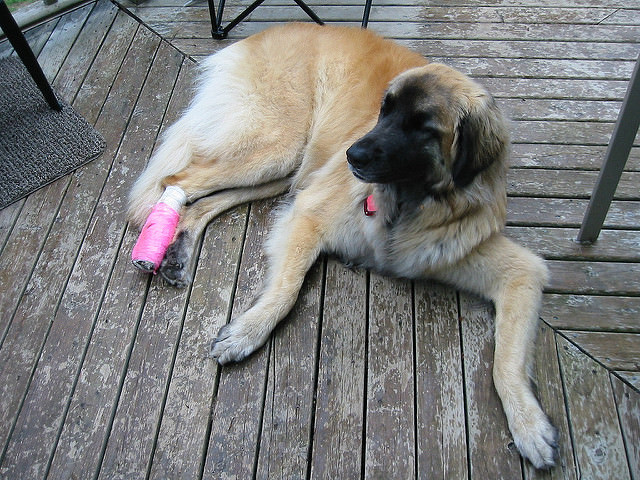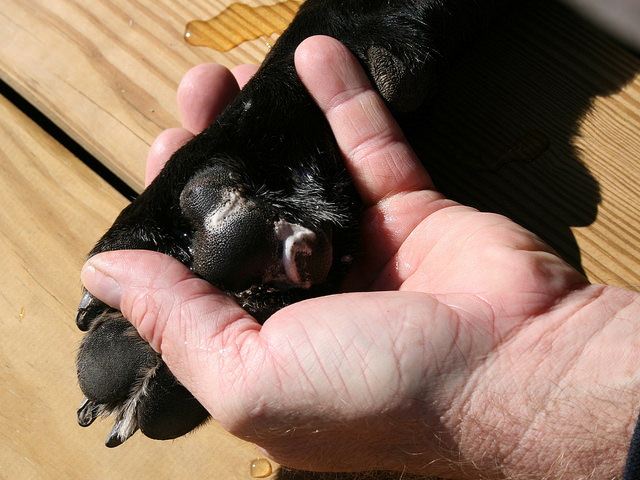Almost all dog owners have had a dog start limping at one time or another. Although alarming at first, it’s not always cause for panic. There are probably thousands of reasons your dog may suddenly come up lame. Some are certainly more problematic than others, but generally speaking you will often need only a single veterinary visit to find the diagnosis. Lameness can and does happen in dogs of every age, breed, size and degree of health, so don’t be surprised if your athletic youngest comes up with a limp. Since there are so many causes, we can’t cover them all, but we can certainly discuss a few of the most common.
#1 – Injury
Injuries are probably the most common causes of lameness in dogs and they range from very minor to quite severe. Injuries are most notable because of their sudden onset, especially during or after physical activity like running or jumping. Bruises and strains to muscles and tendons from overexertion or minor impact are common in younger dogs with less self-preservation skills (we all know the dog that will jump off a cliff for a frisbee). More serious injuries include torn ACLs (called CCL or cranial cruciate ligament in dogs), fractures and dislocations also occur. Regardless of the cause, veterinary attention should be consider if your dog does come up lame after physical activity. Our dogs are stoic creatures, so what might look like a mild limp to you could be a sign of a serious injury in your dog.

#2 – Osteoarthritis
Just like humans, dogs begin to experience musculoskeletal weakness as they age. Regardless of your dog’s overall health, osteoarthritis may begin to set in. This is very common and will likely present in limping or stiffness in the bones and joints, most noticeable when our dogs begin to have difficulty moving around. Osteoarthritis is generally treated by managing the condition and most owners and veterinarians are able to come up with a workable plan for aging dogs.
#3 – Dysplasia
Hip and elbow dysplasia are relatively common ailments in dogs regardless of breed or mixed breed. Although some are genetic prone to the condition, it has been seen in dogs of nearly every shape, size and background. The disease is characterized by the malformation of the elbow or hip joint, making them sit awkwardly in the socket. It can be mild, showing no symptoms, or very severe, requiring surgery to offer comfortable mobility. Dogs are often diagnosed early in life if they are symptomatic because they show lameness that seems not to improve after crate rest and other treatments. Without surgical intervention, these diseases are lifelong. However, many dogs are able to live comfortable, normal lives on alternative treatments.

#4 – Panosteitis
Panosteitis is a condition similar to growing pains in humans. Large breed dogs such as German Shepherds and Great Danes are most susceptible to this disease. The cause is not known and treatment varies, but all of the dogs eventually grow out of the ailment. Panosteitis can present as minor limping or total lameness in any number of legs. Sometimes the lameness will move from leg to leg over a period of weeks, always presenting as acute pain without injury. Panosteitis is a strange condition that still isn’t fully understood.
#5 – Paw Problems
Injury to the feet will also cause a dog to come up lame. Many times when we think there is an issue with the leg, it’s simply an issue with the paw. Torn pads, broken toenails, fractured toes and even stickers or bee stings can cause a dog to show acute lameness. If your dog does start limping, it’s always a good idea to check the feet for injury before immediately assuming it’s one of the legs. Although rare, panosteitis has also been reported in paws of affected dogs.

